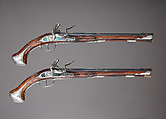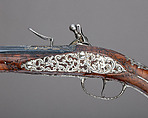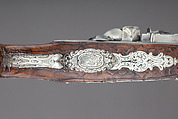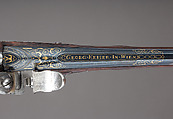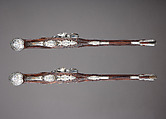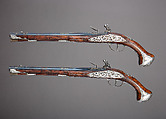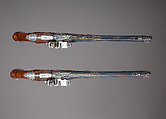Returned to lender The Met accepts temporary loans of art both for short-term exhibitions and for long-term display in its galleries.
Pair of Flintlock Holster Pistols with the Arms of Liechtenstein
Gunsmith Georg Keiser Austrian
Not on view
With the establishment of a gunmakers’ guild in Vienna in 1661 and the subsequent flowering of that craft in the late seventeenth century, the court of the Holy Roman Emperors acquired a highly skilled local source for their sporting arms. By the early eighteenth century Viennese gunmakers had developed a distinctive and colorful style characterized by richly blued and gilt barrels, brightly polished locks engraved with Baroque scrollwork, and carved walnut stocks mounted in gilt bronze or engraved silver.
Distinguished by their exquisite execution, fine condition, and princely provenance, these deluxe pistols exemplify the Viennese school at its best. Georg Keiser, the city’s pre-eminent master, made them about 1720 for a member of the princely house of Liechtenstein, whose heraldic arms are engraved on the silver escutcheon on the back of the grip. Born in the Bohemian town of Eger (now Cheb in the Czech Republic) in 1647, Keiser is notable in the annals of arms making not only for the quality of his work but also for his longevity. On a flintlock hunting gun in the Princely Collections of Liechtenstein in Vaduz the venerable master inscribed his age, "93 years old," attesting to his continued work into old age.
The holdings of the Department of Arms and Armor contain only one other comparable example of Viennese gunmaking, a pair of well-made, but otherwise plain brass-mounted flintlock pistols, also by Keiser, dating to about 1710 (acc. no. 28.100.12, .13). They make an instructive contrast to the deluxe pair under discussion.
Due to rights restrictions, this image cannot be enlarged, viewed at full screen, or downloaded.
This artwork is meant to be viewed from right to left. Scroll left to view more.
